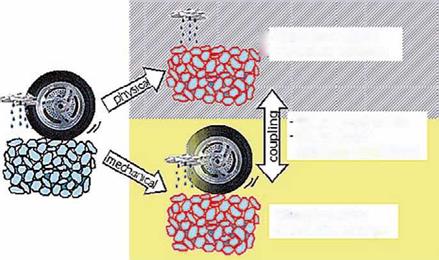Coupled Physical-Mechanical Water-Induced Damage
One of the important realizations is that the problem cannot be solved by mechanical considerations alone. Clearly, water has an effect on the material characteristics of the asphaltic components and their bond, even without mechanical loading. Therefore, both physical and mechanical water damage-inducing processes are included in the model. Another realization is that, in order to acquire a fundamental insight into the processes which cause water damage, the asphaltic mixture needs to be considered at a micro-scale. This implies that the experimental characterization and the computational simulations of the water damage-inducing processes must be dealt with at mixture component level; i. e. the aggregates, the mastic, the bond between the aggregates and the mastic and the (macro) pore space. Each of these
 p – Moisture diffusion Ш -»Advective transport
p – Moisture diffusion Ш -»Advective transport
Weakening of mastic Weakening of aggregate-mastic bond
-Mumpirg action – Mechanical damage
Fig. 5.7 Separation of water damage into physical and mechanical processes (Kringos, 2007) contributes to the mechanical performance of the mixture as well as to its moisture susceptibility.
The physical processes that have been identified as important contributors to water damage are (c. f. Chapter 6, Section 6.3.1):
• the molecular diffusion of water through the mixture components and
• the advective transport, i. e. ‘washing away’, of the mastic due to the moving water flow through the connected macro-pores.
A mechanical process that is identified as a contributor to water damage is the occurrence of intense water pressure fields inside the mixture caused by traffic loads and known as the ‘pumping action’. In the model, these physical material degradation processes interact with a model for mechanical damage to produce the overall water-mechanical damage in the mixture – see Fig. 5.7.






Leave a reply